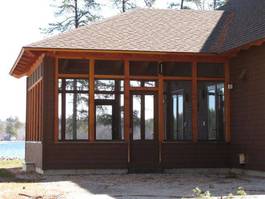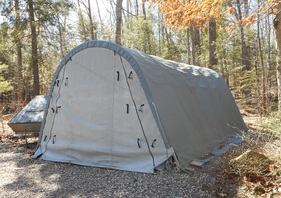Spring 2016 Vol. 29 No. 1
In this edition:
 While the
Chapter 1000 guidelines were changed to the new nonconforming structure
expansion rule over a year ago, many municipal ordinances have not yet
been amended and still use the 30% floor area and volume expansion
provision. This causes us to revisit the issue of screen porches and
the volume calculation.
The
question that arises is whether a screen porch should be counted toward
the volume calculation, whether there is an existing or proposed screen
porch. How to treat open decks, or decks with a roof is fairly routine
for many of you, decks only have floor area because there are no fixed
exterior walls associated with them. However, screen porches are a bit
less obvious.
It is the
Department’s opinion that a screen porch with no fixed exterior walls,
screening from floor to ceiling with minimal support members for the
screening to attach to function more as an open deck than an enclosure,
and therefore we would suggest counting it only as floor area (no
volume). Municipalities may treat this scenario more strictly by
counting such areas as floor area and volume. Regardless of which
position a municipality chooses, they must apply the position
consistently, whether a screen porch is already existing or being
proposed.
On the other hand, when a screen porch
includes fixed exterior walls at least 3 feet in height, municipalities
must count the existing or proposed porch as containing volume. If
nothing less, this type of issue should hopefully further convince
municipal officials to amend their ordinances with the new
non-conforming structure expansion provision where volume calculations
are no longer necessary!
|
 The popularity of using portable shelters in the shoreland zone has not
seemed to have waned over the years and we continue to receive questions
about them. Are they structures? Must they meet shoreline setback
requirements? Do they count as non-vegetated surfaces (lot coverage)?
Yes, yes, and yes. The definition of a structure in Chapter 1000 very
clearly regulates such structures. It does not make any difference
whether the structure is temporary or portable as it still must meet all
shoreland zoning standards. If it can meet the standards, which is
often the case, then go ahead and issue your local permit to allow it.
|
Imagine this scenario: a landowner cuts down most of the trees and removes the duff layer leaving eroding exposed soil within the shoreland zone buffer on a lakefront property, and the CEO issues a Notice of Violation (NOV) to the landowner for the violations. The NOV specifies the temporary (erosion control) and permanent actions required, including extensive replanting to re-establish the buffer.
The landowner really wants to keep the newly unobstructed view to the water, refuses to comply and files an appeal of the CEO’s issuance of the NOV to the local zoning board of appeals (ZBA). In many municipalities in Maine a ZBA may not meet but only once or twice each year, if even that. By the time that the ZBA hears the appeal and makes a decision the window of opportunity to stabilize the soil and replant the site has been lost to seasonal changes (e.g. hot dry summer or frozen winter conditions). And, if the violator does not embrace the ZBA’s denial decision he can now appeal the matter to court, adding further mitigation delays and prolonging soil erosion into the lake.
This type of scenario is one reason that the Chapter 1000 guidelines do not allow an appeal of a CEO’s enforcement action to the ZBA. The proverbial door is still open for a person subject to enforcement action to appeal to court, particularly to provide relief in the outside chance that a CEO makes an error in such action. Many municipal ordinances still allow appeals of enforcement actions to the local ZBA. Since it ought to be a goal of municipalities to see violations mitigated as expeditiously as possible, municipal officials should consider eliminating the ability to appeal enforcement actions to the ZBA as it amends the ordinance to be consistent with the most recent Ch. 1000 guidelines.
 We are pleased to announce that Dawn Abbott has recently joined the Department’s Shoreland Zoning Unit in our Bangor regional office. She has worked for the State in other positions for many years, most recently with the DHHS Drinking Water Program’s compliance division. She has quickly proven to be a valuable asset to the Shoreland Zoning Unit and we are confident that municipalities in the Bangor and Presque Isle regions will enjoy working with her on shoreland zoning matters. She may be reached by phone at 356-8318, and by email, dawn.abbott@maine.gov
|
Q. A structure is non-conforming from a shoreline from the front of the structure since it is only 42 feet from the shoreline, but the structure is even closer to the shoreline of a cove on the left side of the structure where it is 28 feet from the shoreline. Which setback do I use for determining in-fill expansion?
A. Actually both setback distances apply, but they only apply to their respective sides of the structure. In other words an expansion on the front of the structure can be no closer than the closest point, in this case 42 feet from the shoreline, and similarly on the left side no expansion can be any closer than 28 feet from the shoreline. This is the same principle as a peninsula property. Another way to think of it is in terms of property line setbacks. Assume for instance that an ordinance requires a property line setback of 15 feet for structures. A structure that is only set back 4 feet from one lot line does not somehow justify allowing a structure to be expanded to be as close as 4 feet from any other lot line.
During this year’s workshops we will again be discussing the 2015 Ch. 1000 shoreland zoning guidelines changes, and briefly cover the process of amending ordinances. Local officials such as planning board & select board members, in addition to code enforcement officers, are encouraged to attend. Information presented will be applicable whether or not the local ordinance was amended after the 2006 Guidelines.
Afternoon field sessions will again be incorporated into the workshops. The field exercise will demonstrate application of both current standards and new provisions of the 2015 Guidelines.
May 19th - Portage Lake, 9 a.m. - 4 p.m.
May 12th - Yarmouth, 9 a.m. – 4 p.m.
May 24th - Augusta, 9 a.m. – 4 p.m.
June 23rd – Greenville 9 a.m. – 4 p.m.
While there were some unexpected delays in preparing it, the 2016 Highest Annual Tide (HAT) elevation spreadsheet is now available. These elevations should be used by surveyors, municipal officials, landowners, and others to establish the upland edge of a coastal wetland. Once established, shoreland zoning dimensional standards (e.g. setback, lot area, shore frontage, lot coverage, etc) can be determined from the location of this elevation. Please click on the following link to download a copy of the 2016 HAT Table.
|